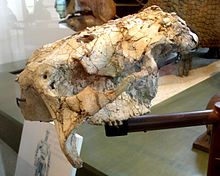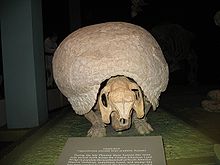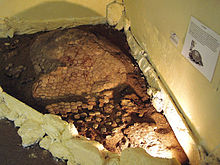- Glyptotherium
-
Glyptotherium

Recreación artística de Glyptotherium.Estado de conservación Extinto (fósil) Clasificación científica Reino: Animalia Filo: Chordata Clase: Mammalia Superorden: Xenarthra Orden: Cingulata Familia: Glyptodontidae † Género: Glyptotherium † Especies - G. arizonae
- G. cylindricum
- G. floridanum
- G. mexicanum
- G. texanum
Glyptotherium es un género extinto de glyptodonte, un grupo de mamíferos parientes del armadillo. Su género es considerado un ejemplo de megafauna norteamericana, la cual la mayoría se extinguió. Glyptotherium pudo haber desaparecido debido al cambio climático o la interferencia humana. Las especies de Glyptotherium se extinguieron aproximadamente hace 12,000 años.[1]
Contenido
Características
Como su pariente vivo, el armadillo, Glyptotherium tuvo una coraza que cubría todo su cuerpo, similar al de una tortuga. De cualquier forma, a diferencia de la caparazón de la tortuga, la coraza de Glyptotherium estaba formada con cientos de pequeños hexágonos (como panal de abeja). Algunas especies crecieron hasta alcanzar los tres metros de largo y tener un cuerpo de una tonelada de peso.
Las especies de Glyptotherium habitaron en zonas tropicales y subtropicales de Florida, Arizona, Texas y en varios estados de México.
Referencias
- «AMNH Bestiary». Consultado el 18-06-2006.
Véase también
- Glyptodontidae (genero)
- Doedicurus
- Glyptodon
- Panochtus
Enlaces externos
 Wikimedia Commons alberga contenido multimedia sobre Glyptotherium. Commons
Wikimedia Commons alberga contenido multimedia sobre Glyptotherium. Commons- Animales Prehistorios
Categorías:- Fósiles
- Glyptodontidae
Wikimedia foundation. 2010.



